Tags
D.B. Weiss, Game of Thrones, Jon Snow, Kit Harrington, Medieval Europe, Military Stuff, Ramsey Bolton, The Battle of the Bastards, Winterfell
So on this week’s episode of Game of Thrones (S06E09, “The Battle of the Bastards”) we finally got to see the confrontation between Jon Snow (Kit Harrington) and Ramsey Bolton (Iwan Rheon). According to D.B. Weiss, speaking in the post-episode analysis, this was their opportunity to show “a true medieval pitched battle, where two sides bring all the forces they can into play…and they go at each other until one of them wins and the other one loses.” But if what they were trying to do is give the viewers a “true medieval pitched battle,” they failed pretty badly. I’m not really an expert in medieval warfare, although I have taught a class on the topic (history departments ask people to teach all sorts of things outside their research fields…), and as the battle sequence went on, I got more and more irritated, because pretty much everyone involved behaves stupidly at one point or another. And the battle itself is a poor representation of a medieval field battle.
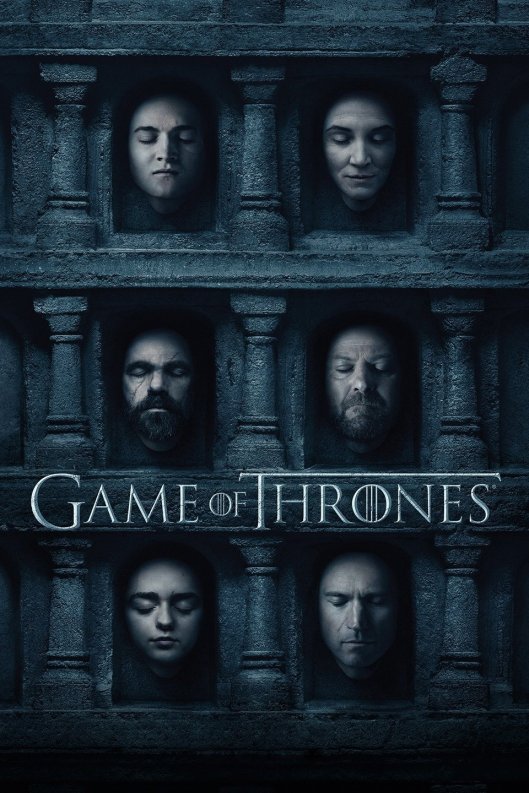
The Forces
Let’s start by talking about the troops involved. Snow’s forces are described as being outnumbered 2 to 1, so he seems to be commanding a force of around 2,000 men against Bolton’s 4,000. During the scene in the command tent before the battle, the map they are looking at would seem to suggest a 3 to 1 ratio, which would suggest that the Bolton forces are closer to 6,000. So the whole battle involves between perhaps 6 and 8,000 men.
He has two major sets of troops: Wildlings and Westeros Cavalry. Right away we run into the problem that the show is mixing chronologically disparate forces. The Wildlings are typical Hollywood barbarians, using swords, long knives, and bows, and wearing nothing better than furs for armor. They represent a Hollywood version of early medieval Germanic tribesmen. The Wildlings are basically light infantry—lightly armored and highly mobile, which makes them good for raiding and skirmishing, but poorly suited for open-field battles except against other light infantry.
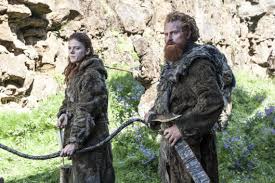
Ygritte and Tormund, equipped like typical Wildlings
The rest of Snow’s troops are Westeros cavalry, basically high medieval knights; they wear a mixture of leather, chainmail, and plate armor, but none of them seem to be as heavily armored as a 14th or 15th century knight would be (when the Knights of the Vale show up, they are properly armored as late medieval knights). Their initial tactic is a lance charge, which aims to break infantry because the lance has a much longer reach than most infantry weapons, but to be really effective, the charge has to be done en masse with a properly dressed line (meaning that the horses are all roughly abreast). Only fairly disciplined infantry will be able to hold formation in the face of a large group of knights on horseback charging across the field; less disciplined troops will generally break ranks and scatter. After the lance charge, the Westeros cavalry follows up with swords for close fighting.
In contrast, Bolton’s forces are structured around what I’ll call Westeros infantry, Northerners living south of the Wall. They wear leather armor and iron helmets, putting them in the category of late medieval medium infantry. They fight using pikes, long spears capable of reaching an opponent long before the opponent can reach them. They’re well-disciplined, which means they can probably withstand a cavalry charge, since their pikes can hit the knights or the horses before the knights’ lances can hit them. Additionally, because horses will not knowingly charge into an unmoving object, the horses are likely going to slow down as they near the infantry line, weakening the force of the charge.
Bolton’s infantry contains troops equipped with special shields, large enough to cover an entire human body. This is a rough approximation of a late medieval pavise, a large convex shield that often had a spike on the bottom to enable it to be set into the ground and remain standing. Historically, a pavise was usually carried by a soldier whose entire job was to carry the shield, while a second man, armed with a crossbow, fired at the enemy. After taking a shot, the crossbowman would duck behind the pavise, which provided cover while the crossbow was being reloaded.
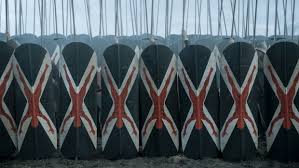
The Bolton Pavisers
But Bolton’s men are trained in an entirely different tactic, one that draws off of ancient phalanx warfare and early medieval shield walls. The paviser advances in a line with his fellows, and then plants the pavise on the ground, creating a literal wall of shields, while his teammate, armed with a pike, stands behind the pavise and attacks over the shield. The spike on the pavise makes it hard for an opponent to knock down the pavise assuming the paviser is bracing it. These two-man teams operate in 3 or 4 ranks, so that if one team is killed, the team behind them can step in to close the gap. On command, the pavisers lift the pavise, advance, and then replant it. It’s an ingenious weapons system and one that’s certainly possible with late medieval technology, but to the best of my knowledge, no such weapon system was ever employed anywhere in world history. The closest parallel I know of is the Greek hoplite phalanx, in which each man carries a shield and spear and relies on the ranks of men behind him to keep him from being pushed backward; it’s similar, but not the same.
Bolton also has a large force of Westeros cavalry and a large number of archers armed with late medieval Welsh longbows. He has far more archers than Snow does, and perhaps roughly the same number of cavalry, because during the first phase of the battle, the two cavalry units cancel each other out and we don’t see them later on, suggesting most of them have been forcibly dismounted during the initial clash.
The Battle of the Bastards could never happen in medieval Europe, because there never was a point when early medieval light infantry, high medieval cavalry, late medieval medium infantry, and late medieval longbowmen were all present at the same battle. Nor were the Bolton pavisers a real thing. So this battle is at best a pastiche of medieval battles. And in the post-episode interview, it’s noteworthy that the two historical inspirations mentioned by Weiss, namely the battle of Cannae and the American civil war, are not medieval; Cannae was fought between the Romans and the Carthaginians in 216 BC, while the American Civil War was fought in the 1860s.
One nice detail though is that the troops are arranged in ranks and units. The way the troops are positioned on the battlefield looks plausibly medieval. Ramsey probably should have positioned his cavalry on the flanks of his position rather than behind the archers, because if they are on the flanks, they could protect the Bolton forces from flanking maneuvers. But perhaps Ramsey is assuming that Snow won’t risk a flanking maneuver knowing how small his army is.

A good shot showing the organization into ranks and units
The Battle of the Boneheads
Another reason this sequence isn’t really indicative of medieval battles is that nearly everyone in the battle engages in rampant stupidity. Yes, medieval generals occasionally did dumb things, but this much idiocy, evenly spread around the field, simply strains credulity.
Bonehead 1: Sansa Stark (Sophie Turner). She knows that Little Finger and the Knights of the Vale are on their way to help, but she never once mentions this fact during the tactical meeting before the battle. The intelligent thing to do is to tell Jon that if he waits a few more days, they will have a lot more troops to work with. Instead, she allows her brother to risk their entire military force in a desperate gamble against bad odds. (And while I’m on the subject of Sansa, somehow, by the end of the battle, she’s moved from the Snow side to behind the Bolton side, because the Knights of the Vale ride past her as they are bearing down on the back of Bolton’s position.)
Bonehead 2: Jon Snow. Snow’s battle plan as discussed in the tactical meeting is to get the Boltons to go on the offensive against the center of his line, whch is the Wildlings. The Wildlings will fall back, drawing the Bolton forces deeper in and enabling Snow’s cavalry and archers to encircle them, thus trapping them in a pincer movement. This strikes me as a lousy plan for several reasons. First, the Wildlings simply cannot stand up against a proper knightly charge; they lack the discipline, as Tormund actually comments at one point, and without spears they have no hope of stopping a cavalry charge. So when Bolton’s cavalry charges, the Wildlings will not so much fall back tactically as they will scatter and rout. That means the cavalry will not be trapped in an encircling maneuver because they can simply ride out through the back end and wheel around to attack the encircling troops from behind. If this is actually Snow’s plan, it’s a bad one.
Additionally, given that Bolton had a lot of archers, he has no reason to bother advancing further than arrow range. He can just order his archers to rain arrows down on Snow’s position, causing casualties while taking few himself (since Snow has fewer archers). Snow is gambling that he can goad Ramsey into charging, but he has no clear plan for how he’s going to do that. Jon might be a good swordsman, but he seems to be a shitty general.
Bonehead 3: Melisandre (Carice van Houten). The woman is a witch, capable of working magic. Some of her magic requires royal blood, but some of it doesn’t, since she apparently changes her appearance without royal blood, and she can perform pyromancy (divination by fire-gazing). So why doesn’t she help out with magic? Maybe she can’t conjure a shadow demon without king’s blood, but is she really completely useless? Can’t she use her pyromancy to give Jon some warning of what he might face? And even if she can’t, why doesn’t he ask for her help anyway; he doesn’t know her limits.
Bonehead 4: Rickon Stark. He doesn’t seem to understand that running in a straight line from a guy with excellent archery skills is a losing proposition. He ought to be zig-zagging, because it reduces the odds of Ramsey hitting him. Ok, he’s young and frightened, so I suppose we can overlook that. But still, not bright.
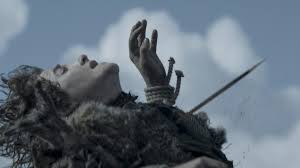
Should have zig-zagged, kid
Bonehead 5: Jon Snow again. Despite being warned that Ramsey will goad him into doing something foolish, he lets Ramsey goad him into doing something foolish, namely charging the Bolton forces on his own. His stupidity nearly destroys everything, because if he’s killed at this point, the battle is pretty obviously over before it starts. Yes, he’s supposed to be furious, but Kit Harrington’s mediocre acting skills mean that he just can’t sell it to the viewer.
The result is that Snow’s forces have to make an unplanned charge against the Bolton line under withering arrow fire. The cavalry line starts out dressed, but quickly loses coherence and loses most of its value as a massed charge. The cavalry charge forces Tormund to commit the Wildlings to also charge across the field, and they also lose all formation. This fits popular imagination of how medieval battles happen, but bears little relationship to actual medieval battles, which were much more organized than we see here. (incidentally, high and late medieval cavalry rarely made lance charges against other cavalry, except during tournaments. That was far more dangerous than charging infantry. So that’s another way the Battle of the Bastards isn’t medieval.)
Also Snow, Ramsey, Tormund, Davos and every other character is going bare-headed, which is suicidally dumb. But it’s clearly done to allow the audiences to see who’s doing what, so I suppose we can forgive it. What’s harder to explain is the near total lack of shields and decent armor. Snow charges into battle wearing nothing but a coat of plates.

Note the lack of helmets and metal armor
Bonehead 6: Ramsey Bolton. Instead of using his pike infantry to break the charge of the Snow cavalry, which is something that late medieval infantry was quite good at, he orders his cavalry to counter-charge, which means he winds up losing most of his cavalry as the two forces decimate each other. A needless waste of men.
Bonehead 7: Ramsey Bolton again. Ramsey has more men in the battle, by a ratio of 2 or 3 to 1, although he hasn’t sent in his pikemen and pavisers yet. When he orders his archers to open fire, that means his archers have a greater chance of killing Bolton troops than Snow troops, simply because there are more Bolton troops on the field. Ordering his men to continue firing is presented as villainy, especially since Davos refuses to do the same thing, but what he’s really doing is evening the odds and helping Jon Snow. And it simply wasn’t done historically, because it’s a really dumb thing to do.
One of the unexplained puzzles of Game of Thrones is how Ramsey, who is clearly a psychopath willing to kill anyone around him, maintains the discipline and loyalty of his troops. Killing his own men is going to demoralize the other troops who are watching this, because they know that when they go into battle, he might continue this archery. My best guess is that Ramsey actually has an unmentioned magical ability that inspires loyalty. Maybe THAT’s what the ritual of burning the flayed and crucified corpses does.
Bonehead 8: The giant. He’s obviously much stronger than a normal man, but he’s fighting with his bare hands. What he ought to be doing is using some sort of club or similar mass weapon, because that would enhance his ability to attack infantry. He would have been much more successful at smashing through the line of pavisers with a club. And given that he’s much stronger than the pavisers, he could surely push a hole through them if he focused. Smart like ox, strong like tractor.
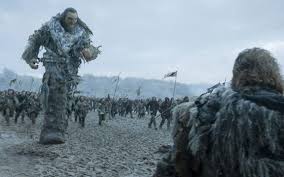
Bonehead 9: Davos (Liam Cunningham). Instead of committing his archers to fight as regular infantry, he ought to have maneuvered his archers to enable them to either start firing on Bolton’s archers or the pavisers. The encircling tactic the pavisers use must be well-known in the North, so it can’t have been a surprise. So once the pavisers get deployed, Davos’ archers would be able to pick them off from behind. Pike infantry loses most of its effectiveness if it loses unit cohesion, and being attacked from behind would do just that. Perhaps not totally boneheaded, but probably short-sighted.
Bonehead 10: Ramsey Bolton once more. Despite having a surplus of troops, he doesn’t bother sending out scouts to make sure that Snow doesn’t have any troops sneaking up on him from another position. How do we know he didn’t do this? Because the massive force of the Knights of the Vale were able to sneak up on him. Having scouts and lookouts is just basic tactical sense, and Ramsey’s forces are clearly battle-hardened, so Ramsey must have learned the value of scouting before this.
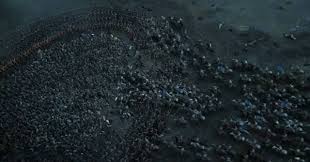
Some scouts might have prevented this
So what should Jon Snow have done? Not fight at all. He should have focused his efforts on things the Wildlings are good at, like raiding and skirmishing. He could have harassed Bolton’s forces, drawn them into ambushes, and otherwise disrupted Ramsey’s ability to project an image of strength and competence. Eventually, Ramsey would have made a mistake that Jon could have pounced on. Yes, winter is coming, but the Wildlings know how to handle winter.
Another Problem with the Battle
As the fight goes on, the field develops a large mound of corpses roughly 10-12 feet high. Ramsey uses that to trap Snow’s forces by encircling them with the pavisers and slowly tightening the circle. When Snow’s troops try to climb the mound of bodies, Bolton’s infantry drives them back into the killing zone. The only thing that saves Snow’s men is the arrival of the Knights of the Vale.

Snow’s army trapped by the pavisers
But it’s highly unlikely that this battle would generate such a mound of corpses. First, given that the entire battle involves less than 10,000 men (at least until the Knights of the Vale arrive), it’s unlikely that there were enough casualties to create such a mound. Yes, such mounds did occasionally form during Civil War battles, but those were battles with many more troops; battles with 30-40,000 combatants were not uncommon, and 19th century gunpowder weapons could cut down large numbers of men in one spot. But at the point by which the mound has formed, it’s unlikely that more than 3000 men are dead. And those corpses would have been strewn across the battlefield, not concentrated in one place.
There is only one medieval battle I know of where a mound of corpses is said to have become an issue, and that’s the battle of Agincourt in 1415. At Agincourt, the English successfully channeled the attacking French into an increasingly narrow zone by positioning themselves between two groves of trees and then erecting stakes to restrict where the horses could charge. Chronicle sources do claim that a mound of bodies as tall as a man formed and that the French infantry had to climb over the bodies to get to the English, which blunted the force of their charge. So as the French charged, they were slowed by the bodies ahead of them and the English archers were able to cut them down and add to the pile. But that’s because the French had a restricted zone through which they could move, whereas at the Battle of the Bastards, the Bolton end of the field appears to be entirely unmodified, except for six burning crosses. There is no reason why charging troops would have to climb over a slowing growing pile of bodies when they could more easily run around it.
So although the battle sequence is well-filmed, it doesn’t give the viewer much of a sense of what a genuine medieval battle could have looked like. It’s a fantasy battle.
One Other Thing: Winterfell is supposed to be an incredibly strong fortress, but it certainly doesn’t look like it in this episode. The castle seems to have been built on flat ground. Its main gateway consists of a stone wall perhaps 20 feet high, flanked by a pair of towers at least 30 feet high. It has only a single gate followed by a short tunnel (really just a deep alcove), and no portcullis. Nor does it have a moat. Nor are there projecting towers or walls to restrict an opponent’s ability to approach the gateway or attack them as they do so. Once the giant manages to break the beam holding the gate closed, there is absolutely nothing to stop Snow’s remaining forces from entered the castle bailey.
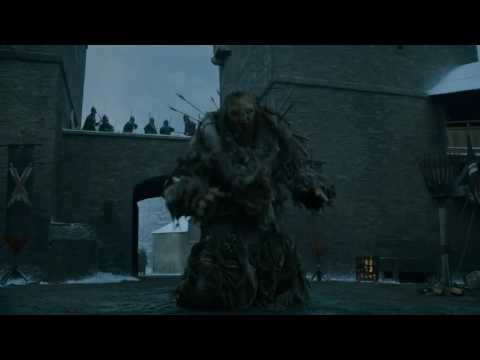
Note the lack of a gatehouse, just a deep doorway
Here’s a shot of Winterfell from a different episode.
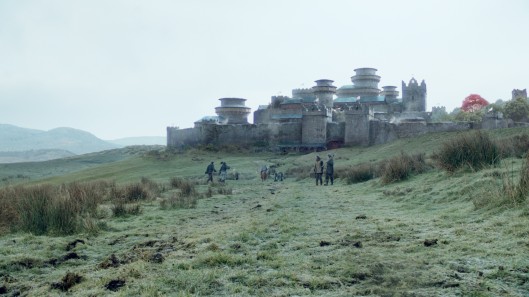
It looks imposing, until you notice how the land slopes upward on the right side, but the wall stays the same height. A teenager with a decent step-stool could break in at that point.
Winterfell pretty much breaks all the major rules of castle building. Castles were almost never situated on open ground within flat terrain, because there’s nothing to stop enemies from simply marching past it, other than the threat of being attacked from behind by the castle forces. As the second picture shows, there are much higher hills nearby that would be better spots for a castle, because castles were typically situated on steep hills or alongside rivers or cliffs, because features like sharply restrict where an attacking force can attack from, and attacking up-hill is difficult.Ccastles are generally built on strategically important spots, like a gorge between high hills (which allow it to control land travel) or alongside a river (allowing it to control water travel). If you have to put a castle out in the open, you put a deep ditch around it, so that the enemy can’t just walk up to the walls.
Here’s a much better example of what the approach to a castle looks like–heavily fortified, with a long tunnel to pass through, providing multiple points for doors or portcullises and places where the garrison can attack the invaders (through holes in the ceiling of the tunnel, for example). Not every castle has a barbican, but a major fortress like Winterfell ought to.

Given how quickly the giant smashed his way into the castle, any reasonable army with a strong battering ram would get in just as fast. The lowness of the walls means that they’re easily scalable, and the lack of a moat means that the enemies can roll siege towers right up to the wall and just walk over onto the parapets. It’s a strikingly unimpressive castle, given the talk about how strong it’s supposed to be.
Update: It’s nice to see that in the next episode, Sansa admits that she was foolish to not tell Jon about the Knights of the Vale being on their way.
Want to Know More?
Rather than referring you to books, like I usually do, I’ll just link to a couple other commentaries on the Battle of the Bastards sequence, which has drawn a lot of analysis.
Here’s an examination of the tactics of the battle as they unfold, in case you had trouble following it. I totally agree that the director did a great job of making the battle make sense.
Acclaimed medieval historian Kelly DeVries has some thoughts about the battle.
This commentator liked the sequence more than I did, although he has a number of the same objections I have about armor.

Interesting to read. I think that Winterfell in the novels is far more sturdy.
And what might be seen as a strategically vital point for Winterfell is that it is built on hot springs, which are made to warm the castle. Considering how cold winter becomes once the Others return, that is probably a huge advantage.
You might also find this article interesting:
http://www.vulture.com/2016/06/battle-of-the-bastards-game-of-thrones-historical-accuracy.html?mid=twitter_vulture
BryndenBFish is one of the most respected ASOIAF commentators, I think, and most of his stuff seems to be on point.
LikeLiked by 1 person
There are some good points there. But I disagree that Agincourt is a good parallel here. The English won at Agincourt because they had far better firepower than the French. In this battle Ramsey clearly has superiority in almost every way. He only has to advance until his archers are in range and then pick off Jon’s forces. And Jon seems to be contemplating an encircling maneuver, which is not what Henry was doing at Agincourt. So I remain convinced that Jon has no business fighting that battle at all.
LikeLike
Jon’s previous experience with a large scale battle was the “Battle of the Wall” in season 4. However it ill prepared him for this since it involved him and the Night’s Watch defending the massive Ice Wall in the North from a Wildling force. Still though Jon played right into Ramsay’s hands and it was only Sansa getting the Knight’s of the Vale and Ramsay’s own stupidity that made him succeed.
On a more mythic note Jon is never wounded during the whole battle. His face is caked in blood and mud by the end of it but none of it is his own. This has fueled speculation that he is in fact the return of Azor Ahai, a legendary figure Melisandre has been waiting for. Speaking of her this is now the third battle in a row she has been no help in, some witch lol.
As for Ramsay no he doesn’t have any kind of magical talent. He ruled strictly by fear and shock tactics. And this was the first major battle he had done solo, his previous victory against Stannis Baratheon could also be contributed to his father’s presence on the field. Clearly we are meant to believe he’d been lucky this whole time and it finally ran out.
LikeLike
Andrew, I think this piece of criticism is a waste of time. It’s about a fantasy battle in a fantasy setting and with badly acting fantastic participants. The books are already unreadable, because based on Hollywood medieval (hence the anachronisms) and full of the cliches of the genre. The films are even worse and use even more Hollywood anachronism, both in sets, costumes, armour and props as in acting. Please, keep to your articles about films that try to portray history; they are well worth reading, very funny and maybe can change minds. Oh, btw: it’s just mail, not chainmail, which is a Victorian invention based on lack of knowedge how a mail shirt (etc.) is made.
LikeLike
I don’t spend much time on fantasy pieces, but I do think there’s some value in exposing the faulty medievalism here. The show does influence how people think about the Middle Ages. And given that this is only my second post about a non-historical subject, I don’t think I’m wasting too much time.
LikeLike
Yes, but shouldn’t the end conclusion of the article be: GoT is not medieval and is just a bad pastiche of real history? Magic and dragons, please!!!!
LikeLike
I do so basically that at the end of my discussion of the battle, though not quite so sarcastically.
LikeLike
I clearly don’t feel that restraint. 😉 Even though my sons liked the books and my wife has seen all the series on tv.
LikeLike
And I really tried to read GoT, but couldn’t get past chapter 2 in the first book. After watching 4 episodes I just felt revulsion because of all the nonsense that was shown. I guess I’m too much of a middle ages nerd.
LikeLike
I’ve never read the books, but fantasy literature was one of my vehicles into studying medieval history, so I actually enjoy the series for what it’s worth, and the acting is mostly quite good, other than Kit Harrington.
LikeLike
First of all, thank you! I don’t care much for Harrington’s acting either, or the character of Jon Snow (loyalty that sways with the wind), but I seem to be one of only a few that holds this opinion. I mean if they were going to bring a Stark back from the dead, Ned or Rob would have been much better. But that brings me to my reason for replying. I’ve seen your opinion of other Hollywood tropes, any thoughts on the whole dead-not-really-being-death trope? Personally I think it’s played out far too much already. And as for this post, as a medieval history buff (though only an amateur) who got started with Dungeons & Dragons, I don’t see a problem at all with pointing out historical inaccuracies in a fantasy world, especially when they claim to be showing a “true medieval pitched battle”.
LikeLiked by 1 person
I sort of liked Jon’s argument that his oath to the Night’s Watch is fulfilled by his temporary death, because that feels genuinely medieval. There were lots of ways in which things like that were considered real escape clauses (for ex. if you’re sentenced to hang and then the rope breaks, there was an argument that you are reprieved because God wants you to live).
LikeLike
Despite being a fan of the books, I stopped watching the show after Season 3 when I came to the conclusion that it wasn’t worth it. So far, I’ve seen no reason to regret that decision. Sure, the books have their fair share of problems, as shown by the author’s admissions that he has no sense for numbers and that the Westerosi wear armor based on what seems cool to him rather than what’s historically accurate, but the show compounds on those problems while also adding more of its own.
For example, Ramsay is actually a huge liability for his house in the books because he has no self-control. As a result, Bolton allies look askance at him, while at least two of the houses in the Bolton camp are planning to turn on them when they face Stannis.
LikeLike
My issue with Ramsey is that he’s a walking cliche of a madman.
LikeLike
I’m not really understanding why his men follow Ramsey, not just in this battle, but at all. Roose was a piece of work, but he was the legitimate lord, he was a good commander, and, for all that he was brutal and cruel, one gets the impression he was tactically brutal, in the “if you cross me, I’ll kill your family” sense and is a decent administrator. In other words, as Roose warns Ramsey in the books about being feared:
“Your amusements are your own, I will not chide you on that count, but you must be more discreet. A peaceful land, a quiet people. That has always been my rule. Make it yours.”
Ramsey is illegitimate, isn’t a good commander, and is psychopathically cruel, in the “Killing your family would be fun!” sense. Why on earth, especially now that the old feudal loyalties seem to have pretty much broken down, do the Bolton knights follow him? Roose has to have some collateral relation who could take over the place as legitimate heir.
LikeLike
Yeah, I entirely agree. He’s a cartoon villain with lots of points in Twirl Mustache and Magically Generate Loyalty.
LikeLike
Well that was an interesting read indeed!
If I may however, can I offer one correction re. Bonehead 1 and Sansa’s position? – It’s simply that Sansa isn’t shown as being with Snow’s battleline at the start of the battle. We see her at the camp the night before and then we don’t see her again until we see her with the Knights of the Vale. 🙂
Everything else you say is spot on 🙂
LikeLike
Sure, but why would she ride over to watch the battle from the Bolton end of the field before the battle is done?
LikeLike
It’s nice to see that in the next episode, Sansa admit that she was foolish to not tell Jon about the Knights of the Vale being on their way.”
I suppose it is better than the show not acknowledging the stupidity of this at all, but Jon’s response is along the lines of ‘We need to trust each other’. My reading of this line and her lack of argument is that the show wants us to believe that lack of trust truly was the reason Sansa neglected to mention the Knights of the Vale.
I can’t think of any reasons beyond poor writing and a lack of understanding of the characters which would lead to Sansa trusting Littlefinger more than Jon. This is just the showrunners forgoing common sense to allow the Knights of the Vale to arrive in the nick of time. It’s of a piece with the 12′ tall wall of bodies, a striking visual image which might seem cool to someone with a poor understanding of logic, or cause and effect, even. I actually love these books, and spend at least 40% of each episode of the show alternately sighing and cringing.
I’d also like to point out that It is you sharing your knowledge of and perspective on history that has led me to read every single post you’ve written here (bar 3 or 4 I just haven’t gotten to yet). So whatever the vehicle you use to explore the topic, whether fantasy TV or the (often equally fantastical) “historical” movies you usually review, I enjoy it all.
LikeLiked by 1 person
Thanks for the kind words. I’m glad you enjoy it. Feel free to repost the articles on FB or whether if you want to show your appreciation!
LikeLike
Two points if I may:
While skirmishing and raiding to draw Bolton out might be tactically sound it is a non-starter strategically. There is a magical multi-year long winter bearing down, and Bolton has already turtled in a (reputedly, suspension of disbelief) impregnable fortress with hot springs and all the provisions. Bolton has little reason to stick his nose out, and Jon probably has about a week before his position disintegrates utterly.
Presumably the immediate environs are stripped pretty clear of provisions. Whatever is left is probably in the hands of the smallfolk. The only way to forage would be to let the wildlings go back to their normal behavior vis-a-vis raiding the smallfolk.
So that would be Jon hurting his smallfolk in the hopes that Bolton will feel so bad for them that Bolton’ll risk every thing to protect them.
As far as the Wildlings go, if they are anything like other northern cultures, pre-prepared shelter, provisions and low population density forms the bedrock of their dealing with winter. They’ll do only marginally better than knights hanging around outside Winterfell without shelter or provisions in winter.
There is nothing to skirmish with, and only Winterfells own smallfolk to raid, whitch means nothing to Bolton. And Jons position is not viable in either the long or medium term. I’ve not seen much of a baggage train.
Second, I expect Boltons cavalry consists of the mercenaries and knights he enticed away from Stannish. Presumably promising them gold and rewards they are expecting him to fork out soon. Also, they are not Bolton men, and also expect Bolton to feed them and their horses through winter.
The Boltons are northerners too, and of a much colder and harder breed than the Starks. The cavalry was in no way anything but a liability to Bolton at this point.
LikeLike
Your first point has some merit. Your second point is, so far as I can see, just guessing.
LikeLike